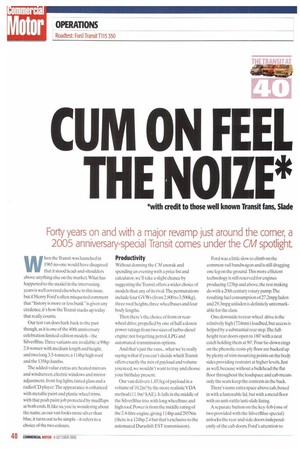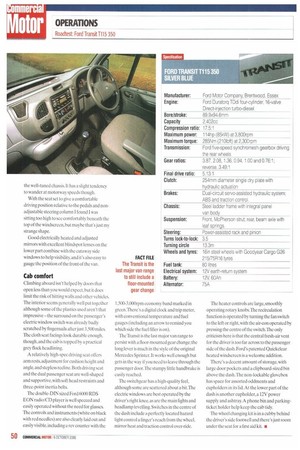CUM ON FEEL
Page 48

Page 49

Page 50

If you've noticed an error in this article please click here to report it so we can fix it.
THE IfICIIIE*
*with credit to those well known Transit fans, Slade
Fort years on and with a major revamp just around the comer, a 2005 anniversary-special Transit comes under the CM spotlight.
When the Transit was launched in 1965 no-one would have disagreed that it stood head-and-shoulders above anything else on the market.What has happened to the model in the intervening years is well covered elsewhere in this issue. but if Henry Ford's often misquoted comment that "history is more or less bunk" is given any credence, it's how the Transit stacks up today that really counts.
Our test van does hark back to the past though,as it is one of the 40th anniversary celebration limited-edition models— the SilverBluelhree variants are available:a 99hp 2.8-tonner with medium length and height, and two long 3.5-tonners; a 114hp high-roof and the 135hp Jumbo.
The added-value extras are heated mirrors and windscreen, electric windows and mirror adjustment, front fog lights, tinted glass and a radio/CD player.The appearance is enhanced with metallic paint and plastic wheel trims, with that posh paint job protected by mudflaps at both ends. If, like us,you're wondering about the name. as our van looks more silver than blue, it turns out to be simple —it refers to a choice of the two colours. Productivity Without donning the CM anorak and spending an evening with a price list and calculator, we'll take a slight chance by suggesting the Transit offers a wider choice of models than any of its rival.The permutations include four GVWs (from 2,8(X) to 3,500kg), three roof heights, three wheelbases and four body lengths.
Then there's the choice of front or rearwheel drive, propelled by one of half a dozen power ratings from two sizes of turbo-diesel engine; not forgetting petrol, LPG and automated-transmission options.
And that's just the vans...what we're really saying is that if you can't decide whichTransit offers exactly the mix of payload and volume you need, we wouldn't want to tray and choose your birthday present.
Our van delivers 1.451kg of payload in a volume of 10,2m by the more realistic VDA method (11.9m3SAE). It falls in the middle of the SilverBlue trio, with long wheelbase and high roof. Power is from the middle rating of the 2.4-litre engine. giving 114hp and 285Nm (there is a 124hp 2.4 but that's exclusive to the automated Durashift EST transmission). Ford was a little slow to climb on the common-rail bandwagon and is still dragging one leg on the ground.This more efficient technology is still reserved for engines producing 123hp and above, the rest making do with a 20th century rotary pump. The resulting fuel consumption of 27.2mpg laden and 29.3mpg unladen is definitely unremarkable for the class.
One downside to rear-wheel drive is the relatively high (724mm) loadbed, but access is helped by a substantial rear step. The fullheight rear doors open to 180° with a neat catch holding them at 90°. Four tie-down rings on the phenolic-resin-ply floor are backed up by plenty of trim mounting points on the body sides providing restraint at higher levels. Just as well,because without a bulkhead the flat floor throughout the loadspace and cab means only the seats keep the contents in the back.
There's some extra space above cab, boxed in with a fastenable lid, but with a metal floor with no anti-rattle/anti-slide lining.
A separate button on the key-fob (one of two provided with the SilverBlue special) unlocks the rear and side doors independently of the cab doors. Ford's attention to security on the current Transit is noteworthy, although these benefits are reduced somewhat without a bulkhead.
On the road
Starting the Transit from cold, first impressions are that it's noisy It quietens when it gets warmer, but not enough. Not helped by the lack of a bulkhead, it recorded the highest readings in its class for quite some time.The greatest noise seems to come from the exhaust, a not unpleasantly sporty sound— there'sjust a little too much of it.To put it in perspective, Radio 4 needs volume 9 to be comfortable at 30mph. but needs increasing to 18 at the motorway limit.
If the 113hp engine's economy is nothing special, its performance is more impressive. It demonstrates excellent flexibility, pulling happily from 1,000rpm (as long as you don't mind a bit of initial resonance) and continuing strongly up through the rev range.At higher speeds it's responsive enough to sometimes make you think you're in third when you're actually in fifth. Few drivers will find the Transit's performance wanting on motorways or around town.
Generally speaking the handling is well up to the performance, the only exception being that there's enough torque for traction to be an issue, even in the dry. It's much too easy to spin the inside rear wheel and the traction control seems to make little difference. While we're on the subject of electronic chassis aids, we still believe that for the £400 or so that it costs,ESP should at least be an option on all vans,if not standard.
The ride is firm and well controlled. while the steering is on the heavy side of the fashionable trend to being a bit overassisted — just right to extract the best from the well-tuned chassis. It has a slight tendency to wander at motorway speeds though.
With the seat set to give a comfortable driving position relative to the pedals and nonadjustable steering column I found! was sitting too high to see comfortably beneath the top of the windscreen, but maybe that's just my strange shape.
Good electrically heated and adjusted mirrors with excellent blindspot lenses on the lower part combine with the cutaway side windows to help visibility, and it's also easy to gauge the position of the front of the van.
Cab comfort
Climbing aboard isn't helped by doors that open less than you would expect, but it does limit the risk of hitting walls and other vehicles. The interior seems generally well put together although some of the plastics used aren't that impressive — the surround on the passenger's electric window switch was already badly scratched by fingernails after just 3,500 miles. The cloth seat facings look durable enough, though, and the cab is topped by a practical grey flock headlining.
A relatively high-spec driving seat offers arm rests, adjustment for cushion height and angle, and stepless recline. Both driving seat and the dual passenger seat are well-shaped and supportive, with soft head restraints and three-point inertia belts.
The double-DIN sized Ford 6000 RDS EON radio/CD player is well specced and easily operated without the need for glasses. The controls and instruments (white on black with red needles) are also clearly laid out and easily visible, including a rev counter with the 1,500-3,000rpm economy band marked in green.There's a digital clock and trip meter, with conventional temperature and fuel gauges (including an arrow to remind you which side the fuel filler is on).
The Transit is the last major van range to persist with a floor-mounted gear change; the long lever is much in the style of the original Mercedes Sprinter. It works well enough but gets in the way if you need to leave through the passenger door. The stumpy little handbrake is easily reached, The switchgear has a high-quality feel, although some are scattered about a bit.The electric windows are best operated by the driver's right knee, as are the main lights and headlamp levelling. Switches in the centre of the dash include a perfectly located hazard light control a finger's reach from the wheel, mirror heat and traction control over-ride. The heater controls are large, smoothly operating rotary knobs, The recirculation function is operated by turning the fan switch to the left or right, with the air-con operated by pressing the centre of the switch.The only criticism here is that the central fresh-air vent for the driver is too far across to the passenger side of the dash. Ford's patented Quickclear heated windscreen is a welcome addition.
There's a decent amount of storage, with large door pockets and a clipboard-sized bin above the dash.The non-lockable glovebox has space for assorted oddments and cupholders in its lid. At the lower part of the dash is another cupholder, a 12V power supply and ashtray.A phone bin and parkingticket holder help keep the cab tidy.
The wheel changing kit is in a cubby behind the driver's side footwell and there's just room under the seat for a first aid kit. •










































































































































































































